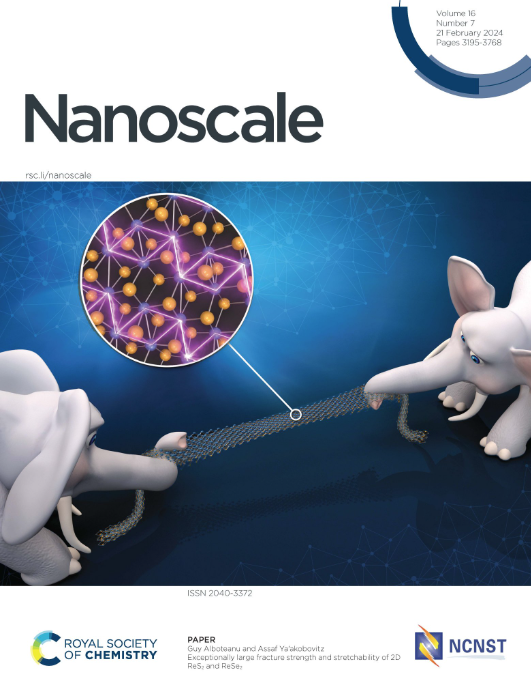调节脂质纳米载体的机械特性以提高胶质母细胞瘤的靶向性和血脑屏障穿透性
IF 5.8
3区 材料科学
Q1 CHEMISTRY, MULTIDISCIPLINARY
引用次数: 0
摘要
纳米载体脂质系统(NLS)已成为诊断和治疗应用的多功能平台,包括药物输送、基因治疗和疫苗开发。最近的进展凸显了它们在针对传染病和治疗肿瘤等病理状况方面的潜力,这主要归功于它们能够有效地封装和递送治疗剂。本研究的重点是合成和表征不同脂质成分的 NLS,以了解它们的物理化学和机械性能,这对它们在生物医学应用中的性能至关重要。研究人员采用溶剂置换法制备了不同比例的橄榄油和硬脂酸 NLS。对这些制剂进行了表征,以确定它们的尺寸、多分散指数和表面电荷。动态光散射和纳米粒子跟踪分析表明,NLS 的尺寸随着硬脂酸含量的增加而增大。NLS 在各种 pH 值和细胞培养基中均表现出稳定性。此外,还评估了生物分子电晕的形成及其对表面电荷的影响,结果显示其对 NLS 的稳定性有显著影响。使用原子力显微镜和流变测试评估了机械性能,包括刚性和变形性。研究发现,增加硬脂酸含量可增强 NLS 的刚性和粘附强度,这对它们在血液循环、肿瘤靶向和细胞吸收等生物系统中的行为至关重要。生物学评估表明,这些机械特性对生物相互作用有显著影响。以纯橄榄油为核心的较软 NLS 在体外血脑屏障模型中显示出更强的转运能力,突显了它们向大脑输送药物的潜力。相反,胶质母细胞瘤细胞摄取研究显示,刚性更强的 NLS 被 U87-MG 细胞内化的效率更高,这表明刚性在细胞进入中的作用。这些发现为优化 NLS 的特定治疗应用提供了启示,尤其是在克服血脑屏障等障碍和针对脑部疾病方面。本文章由计算机程序翻译,如有差异,请以英文原文为准。
Tuning Lipid Nanocarrier Mechanical Properties to improve Glioblastoma Targeting and Blood Brain Barrier Penetration
Nanocarrier lipid systems (NLSs) have emerged as versatile platforms for diagnostic and therapeutic applications, including drug delivery, gene therapy, and vaccine development. Recent advancements highlight their potential in targeting infectious diseases and treating pathological conditions like tumors, largely due to their ability to effectively encapsulate and deliver therapeutic agents. This study focuses on the synthesis and characterization of NLSs with varying lipid compositions to understand their physicochemical and mechanical properties, which are crucial for their performance in biomedical applications. NLSs were prepared using a solvent displacement method, resulting in formulations with different ratios of olive oil and stearic acid. These formulations were characterized to determine their size, polydispersity index, and surface charge. Dynamic Light Scattering and Nanoparticle Tracking Analysis revealed that the size of the NLSs increased with higher stearic acid content. The NLSs demonstrated stability across a range of pH levels and in cell culture medium. The biomolecular corona formation and its impact on surface charge were also evaluated, showing significant effects on NLS stability. Mechanical properties, including rigidity and deformability, were assessed using Atomic Force Microscopy and rheological tests. The study found that increasing stearic acid content enhanced NLS rigidity and adhesion strength, which is crucial for their behaviour in biological systems such as blood circulation, tumor targeting, and cellular uptake. Biological evaluations demonstrated that these mechanical properties significantly influenced bio-interactions. Softer NLSs with a pure olive oil core displayed enhanced translocation across an in vitro blood-brain barrier model, underscoring their potential for drug delivery to the brain. Conversely, glioblastoma cell uptake studies revealed that the more rigid NLSs were internalized more efficiently by U87-MG cells, suggesting a role for stiffness in cellular entry. These findings provide insights into optimizing NLSs for specific therapeutic applications, particularly in overcoming barriers like the blood-brain barrier and targeting cerebral diseases.
求助全文
通过发布文献求助,成功后即可免费获取论文全文。
去求助
来源期刊

Nanoscale
CHEMISTRY, MULTIDISCIPLINARY-NANOSCIENCE & NANOTECHNOLOGY
CiteScore
12.10
自引率
3.00%
发文量
1628
审稿时长
1.6 months
期刊介绍:
Nanoscale is a high-impact international journal, publishing high-quality research across nanoscience and nanotechnology. Nanoscale publishes a full mix of research articles on experimental and theoretical work, including reviews, communications, and full papers.Highly interdisciplinary, this journal appeals to scientists, researchers and professionals interested in nanoscience and nanotechnology, quantum materials and quantum technology, including the areas of physics, chemistry, biology, medicine, materials, energy/environment, information technology, detection science, healthcare and drug discovery, and electronics.
 求助内容:
求助内容: 应助结果提醒方式:
应助结果提醒方式:


